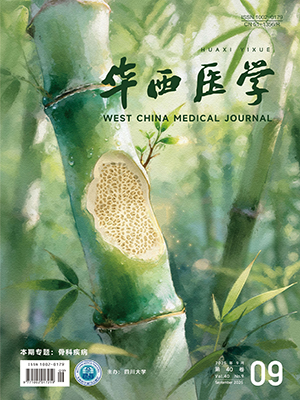| 1. |
Calvet D, Mas JL. Closure of patent foramen ovale in cryptogenic stroke: a never ending story[J]. Cerebrovascu Dis, 2014, 27(1): 13-19.
|
| 2. |
Mascarenhas V, Kalyanasundaram A, Nassef LA, et al. Simultaneous massive pulmonary embolism and impending paradoxical embolism through a patent foramen ovale[J]. J Am Coll Cardiol, 2009, 53(15): 1338.
|
| 3. |
Pavoni D, Zanuttini D, Spedicato L, et al. Large interatrial thrombus-in-transit resulting in acute myocardial infarction complicated by atrioventricular block and cardiogenic shock[J]. J Am Coll Cardiol, 2012, 59(14): 1329.
|
| 4. |
Hara H, Virmani R, Ladich E, et al. Patent foramen ovale: current pathology, pathophysiology, and clinical status[J]. J Am Coll Cardiol, 2005, 46(9): 1768-1776.
|
| 5. |
Mondello E, Panasiti R, Siliotti R, et al. Bis and ramsay score in critically ill patient: what future[J]. Minerva Anestesiol, 2002, 68(1/2): 37-43.
|
| 6. |
González-Alujas T, Evangelista A, Santamarina E, et al. Diagnosis and quantification of patent foramen ovale. Which is the reference technique? Simultaneous study with transcranial Doppler, transthoracic and transesophageal echocardiography[J]. Rev Esp Cardiol, 2011, 64(2): 133-139.
|
| 7. |
Sacco RL, Ellenberg JH, Mohr JP, et al. Infarcts of undetermined cause: the NINCDS Stroke Data Bank[J]. Ann Neurol, 1989, 25(4): 382-390.
|
| 8. |
Berthet K, Lavergne T, Cohen A, et al. Significant association of atrial vulnerability with atrial septal abnormalities in young patients with ischemic stroke of unknown cause[J]. Stroke, 2000, 31(2): 398-403.
|
| 9. |
Lechat P, Mas JL, Lascault G, et al. Prevalence of patent foramen ovale in patients with stroke[J]. N Engl J Med, 1988, 318(18): 1148-1152.
|
| 10. |
Cabanes L, Mas JL, Cohen A, et al. Atrial septal aneurysm and patent foramen ovale as risk factors for cryptogenic stroke in patients less than 55 years of age. A study using transesophageal echocardiography[J]. Stroke, 1993, 24(12): 1865-1873.
|
| 11. |
Freixa X. Cardiac procedures to prevent stroke: patent foramen ovale closure/left atrial appendage occlusion[J]. Canad J Cardiol, 2014(30): 87-95.
|
| 12. |
蔡高昂, 张爱梅, 李宪章, 等. 心脏卵圆孔未闭对不同年龄人群隐源性卒中的影响[J]. 中风与神经疾病杂志, 2013, 30(2): 144-147.
|
| 13. |
Ford MA, AF, Reeder GS, Lennon RJ, et al. Percutaneous device closure of patent foramen ovale in patients with presumed cryptogenic stroke or transient ischemic attack[J]. JACC Cardiovasc Interve, 2009, 2(5): 404-411.
|
| 14. |
Von Bardeleben RS, Richter C, Otto J, et al. Long term follow up after percutaneous closure of PFO in 357 patients with paradoxical embolism: difference in occlusion systems and influence of atrial septum aneurysm[J]. Int J Cardiol, 2009, 134(1): 33-41.
|
| 15. |
杜微. 先天性卵圆孔未闭与缺血性卒中的最新研究进展[J]. 中风与神经疾病杂志, 2012, 29(7): 669-672.
|
| 16. |
Scacciatella P , Butera G , Meynet l , et al . Pereutaneous closure of patent foramen ovale in patients with anatomical and clinical high risk charaeteristies: long-term efficacy and safety[J]. J Intery Cardiol, 2011, 24(5): 477-484.
|
| 17. |
Zito C, Dattilo G, Oreto G, et al. Patent foramen ovale: comparison among diagnostic strategies in cryptogenic stroke and migraine[J]. Echocardiography, 2009, 26(5): 495-503.
|
| 18. |
Komar M, Olszowska M, Przewłocki T, et al. Transcranial doppler ultrasonography should it be the first choice for persistent foramen ovale screening?[J]. Cardiovasc Ultrasound, 2014, 12(1): 16.
|
| 19. |
Telman G, Yalonetsky S, Kouperberg E, et al. Size of pfo and amount of microembolic signals in patients with ischaemic stroke or tia[J]. Eur J Neurol, 2008, 15(9): 969-972.
|
| 20. |
Lee JY, Song JK, Song JM, et al. Association between anatomic features of atrial septal abnormalities obtained by omni-plane transesophageal echocardiography and stroke recurrence in cryptogenic stroke patients with patent foramen ovale[J]. Am J Cardiol, 2010, 106(1): 129-134.
|
| 21. |
Kutty S, Brown K, Qureshi AM, et al. Maximal potential patent foramen diameter does not correlate with the type or frequency of the neurologic event prior to closure[J]. Cardiology, 2009, 113(2): 111-115.
|
| 22. |
Mohr JP, Thompson JL, Lazar RM, et al. A comparison of warfarin and aspirin for the prevention of recurrent ischemic stroke[J]. N Engl J Med, 2001, 345(20): 1444-1451.
|
| 23. |
Homma S, Sacco RL, Di Tullio MR, et al. Effect of medical treatment in stroke patients with patent foramen ovale: patent foramen ovale in Cryptogenic Stroke Study[J]. Circulation, 2002, 105(22): 2625-2631.
|
| 24. |
O’Gara PT, Messe SR, Tuzcu EM, et al. Percutaneous device closure of patent foramen ovale for secondary stroke prevention: a call for completion of randomized clinical trials: a science advisory from the American Heart Association/American Stroke Association and the American College of Cardiology Foundation[J]. Circulation, 2009, 119(20): 2743-2747 .
|
| 25. |
Khairy P, O’Donnell CP, Landzberg MJ. Transcatheter closure versus medical therapy of patent foramen ovale and presumed paradoxical thromboemboli: a systematic review[J]. Ann Intern Med, 2003, 139(9): 753-760.
|
| 26. |
Mirzada N, Ladenvall P, Hansson PO, et al. Seven-year follow-up of percutaneous closure of patent foramen ovale[J]. IJC Heart Vessels, 2013(1): 32-36.
|
| 27. |
Meier B, Kalesan B, Mattle HP, et al. Percutaneous closure of patent foramen ovale in cryptogenic embolism[J]. N Engl J Med, 2013, 368(12): 1083-1091.
|
| 28. |
Carroll JD, Saver JL, Thaler DE, et al. Closure of patent foramen ovale versus medical therapy after cryptogenic stroke[J]. N Engl J Med, 2013, 368(12): 1092-1100.
|




